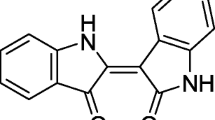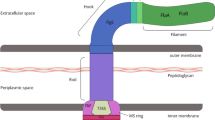Abstract
Bacterial surface layers (S-layers) are cell envelope structures ubiquitously found in gram-negative and gram-positive bacteria, including Lactobacillus. S-layers play a role in the determination and maintenance of cell shape as virulence factors, mediate cell adhesion, and regulate immature dendritic and T cells. In this study, we sought to understand the involvement of MAPK serine/threonine kinases in alterations in Endometrial epithelial cells (ESC) growth induced by Lactobacillus crispatus (L. crispatus) slpA, an S-layer protein. We applied various concentrations of L. crispatus to cultured ESCs and observed growth and changes in the phosphorylation status of ERK1/2, JNK, and p38. Similar experiments were conducted using L. crispatus lacking and overexpressing slpA. We found that ESC growth was altered by slpA primarily via ERK1/2. Our findings suggest that L. crispatus slpA promotes ESC growth mainly through an ERK1/2-dependent pathway.






Similar content being viewed by others
References
Babolmorad G, Emtiazi G, Emamzadeh R (2014) Analysis of the interaction between Bacillus coagulans and Bacillus thuringiensis S-layers and calcium ions by XRD, light microscopy, and FTIR. Appl Biochem Biotechnol 173:103–115
Baneyx F, Matthaei JF (2014) Self-assembled two-dimensional protein arrays in bionanotechnology: from S-layers to designed lattices. Curr Opin Biotechnol 28:39–45
Bobeth M, Blecha A, Bluher A, Mertig M, Korkmaz N, Ostermann K, Rodel G, Pompe W (2011) Formation of tubes during self-assembly of bacterial surface layers. Langmuir 27:15102–15111
Currie DH, Guss AM, Herring CD, Giannone RJ, Johnson CM, Lankford PK, Brown SD, Hettich RL, Lynd LR (2014) Profile of secreted hydrolases, associated proteins, and SlpA in Thermoanaerobacterium saccharolyticum during the degradation of hemicellulose. Appl Environ Microbiol 80:5001–5011
Delhanty PJ, van der Eerden BC, van der Velde M, Gauna C, Pols HA, Jahr H, Chiba H, van der Lely AJ, van Leeuwen JP (2006) Ghrelin and unacylated ghrelin stimulate human osteoblast growth via mitogen-activated protein kinase (MAPK)/phosphoinositide 3-kinase (PI3 K) pathways in the absence of GHS-R1a. J Endocrinol 188:37–47
Fagan RP, Fairweather NF (2014) Biogenesis and functions of bacterial S-layers. Nat Rev Microbiol 12:211–222
Farci D, Bowler MW, Esposito F, McSweeney S, Tramontano E, Piano D (2015) Purification and characterization of DR_2577 (SlpA) a major S-layer protein from Deinococcus radiodurans. Front Microbiol 6:414
Kitaya K, Yasuo T (2013) Regulatory role of membrane-bound form interleukin-15 on human uterine microvascular endothelial cells in circulating CD16(-) natural killer cell extravasation into human endometrium. Biol Reprod 89:70
Lei L, You ZL, Fu LM, Wen LX (2006) Effects of herb therapy for benefiting qi and removing blood stasis on ultrastructure of vascular endothelial cells and vascular smooth muscle cells of uterine endometrium in rabbits with copper intrauterine device. Zhong Xi Yi Jie He Xue Bao 4:60–63
Narita J, Ishida S, Okano K, Kimura S, Fukuda H, Kondo A (2006) Improvement of protein production in lactic acid bacteria using 5’-untranslated leader sequence of slpA from Lactobacillus acidophilus. Improvement in protein production using UTLS. Appl Microbiol Biotechnol 73:366–373
Perras AK, Daum B, Ziegler C, Takahashi LK, Ahmed M, Wanner G, Klingl A, Leitinger G, Kolb-Lenz D, Gribaldo S, Auerbach A, Mora M, Probst AJ, Bellack A, Moissl-Eichinger C (2015) S-layers at second glance? Altiarchaeal grappling hooks (hami) resemble archaeal S-layer proteins in structure and sequence. Front Microbiol 6:543
Quistgaard EM, Nordlund P, Low C (2012) High-resolution insights into binding of unfolded polypeptides by the PPIase chaperone SlpA. FASEB J 26:4003–4013
Reus GZ, Vieira FG, Abelaira HM, Michels M, Tomaz DB, dos Santos MA, Carlessi AS, Neotti MV, Matias BI, Luz JR, Dal-Pizzol F, Quevedo J (2014) MAPK signaling correlates with the antidepressant effects of ketamine. J Psychiatr Res 55:15–21
Sleytr UB, Huber C, Ilk N, Pum D, Schuster B, Egelseer EM (2007) S-layers as a tool kit for nanobiotechnological applications. FEMS Microbiol Lett 267:131–144
Sleytr UB, Schuster B, Egelseer EM, Pum D (2014) S-layers: principles and applications. FEMS Microbiol Rev 38:823–864
Vilen H, Hynonen U, Badelt-Lichtblau H, Ilk N, Jaaskelainen P, Torkkeli M, Palva A (2009) Surface location of individual residues of SlpA provides insight into the Lactobacillus brevis S-layer. J Bacteriol 191:3339–3349
Xiao K, Kong F, Wang Q, Jin P, Thomas L, Xiong L, Zhou H, Gilbert GL (2013) Multiplex PCR targeting slpA: a rapid screening method to predict common Clostridium difficile ribotypes among fluoroquinolone resistant clinical strains. Pathology 45:595–599
Yang Y, Wikiel AJ, Dall’Agnol LT, Eloy P, Genet MJ, Moura JJ, Sand W, Dupont-Gillain CC, Rouxhet PG (2016) Proteins dominate in the surface layers formed on materials exposed to extracellular polymeric substances from bacterial cultures. Biofouling 32:95–108
Acknowledgements
This work was support by National Natural Science Foundation of China (81370767).
Author information
Authors and Affiliations
Corresponding author
Additional information
Ya Tuo was also the co- first author. She did the same work as Jinying He.
Rights and permissions
About this article
Cite this article
He, J., Tuo, Y., Yan, W. et al. Lactobacillus slpA promotes ESC growth through the ERK1/2 pathway. Cytotechnology 69, 117–122 (2017). https://doi.org/10.1007/s10616-016-0043-6
Received:
Accepted:
Published:
Issue Date:
DOI: https://doi.org/10.1007/s10616-016-0043-6




